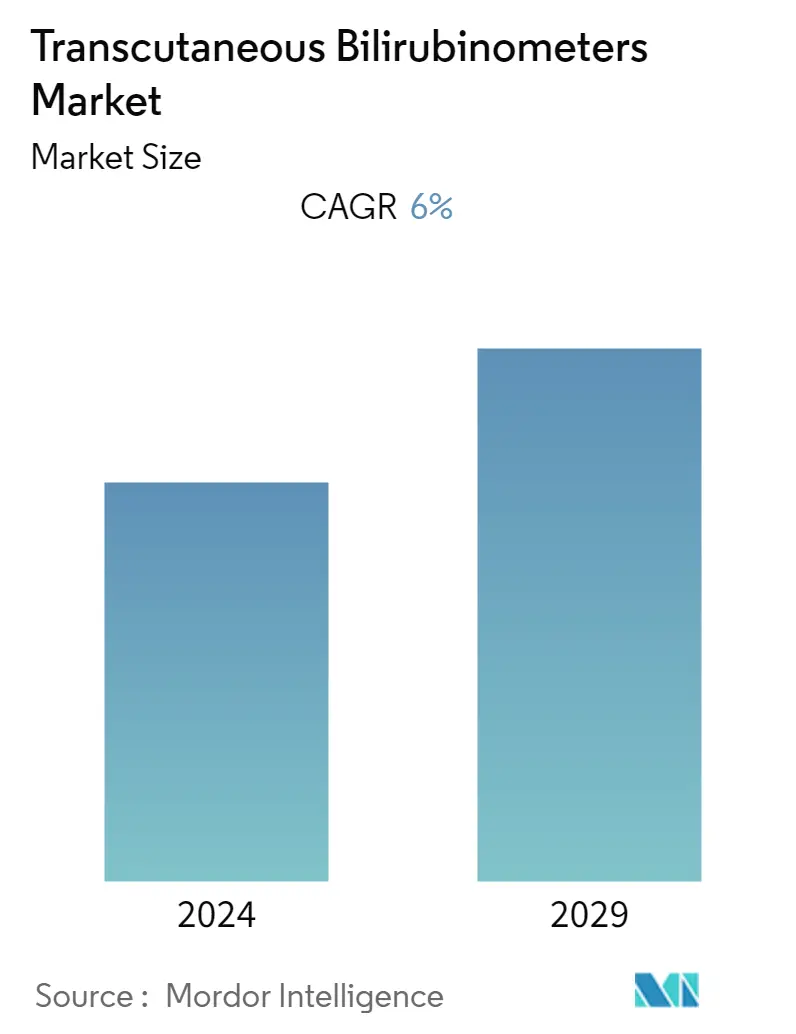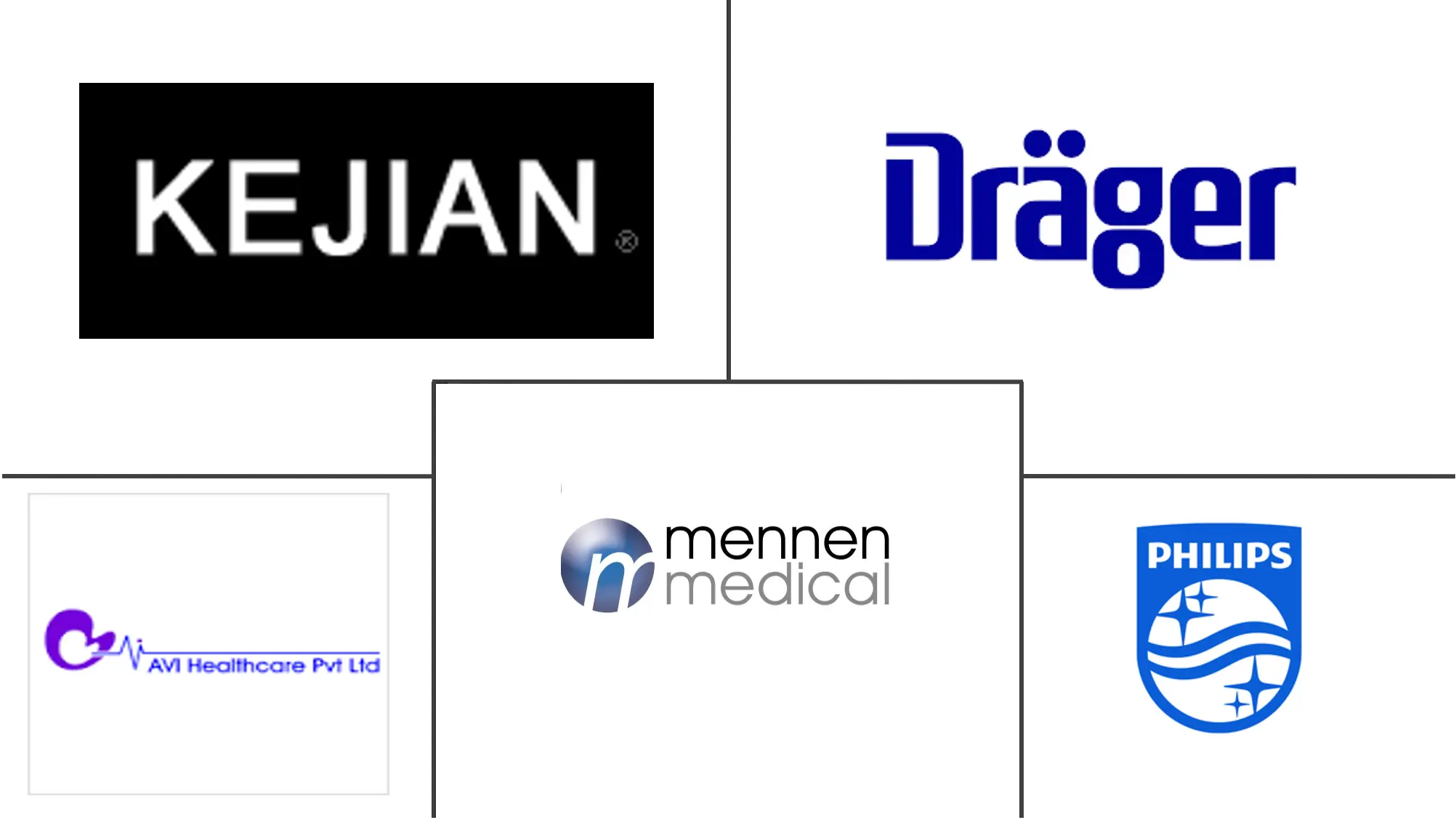Market Size of Transcutaneous Bilirubinometers Industry

| Study Period | 2021 - 2029 |
| Base Year For Estimation | 2023 |
| CAGR | 6.00 % |
| Fastest Growing Market | North America |
| Largest Market | Asia Pacific |
| Market Concentration | Low |
Major Players
*Disclaimer: Major Players sorted in no particular order |
Transcutaneous Bilirubinometer Market Analysis
The transcutaneous bilirubinometers market is expected to register a CAGR of 6.0% during the forecast period.
The COVID-19 pandemic had a significant impact on the market studied. Due to the emergence of COVID-19, governments of countries across the globe took measures to aid the infection globally. Since neonatal jaundice screening necessitates the presence of both parents in the hospital, the spread of infection is increased. As a result, a few countries implemented COVID-19 control measures, such as providing neonate jaundice screening services outside of hospitals and clinics. For instance, as per an article published in the Journal of Pediatrics and Child Health in January 2021, during the initial phase of the pandemic, the Malaysian Ministry of Health introduced the transcutaneous bilirubin drive-through (DT) service to reduce congestion in hospitals. This increased the demand for transcutaneous bilirubinometers. Additionally, in the later phases of the pandemic, demand for transcutaneous bilirubin tests increased, owing to an increase in jaundice cases among the neonate population. This created demand for transcutaneous bilirubinometers and significantly propelled the market growth. Thus, owing to the factors mentioned above, the pandemic impacted the market studied significantly and is expected to witness growth over the forecast period.
Factors such as the rising incidence of jaundice in neonatal patients and technological advancements greatly contribute to the studied market's growth.
Neonatal jaundice is a frequent source of concern for parents and caregivers. It can cause serious problems, including bilirubin encephalopathy if ignored. The condition is very common among neonates globally. As per the August 2022 update of the NCBI data, nearly 60% of term and 80% of preterm newborns develop clinical jaundice in the first week after birth. Additionally, as per the source above, most newborns with clinical jaundice have unconjugated hyperbilirubinemia (UHB), but conjugated hyperbilirubinemia (CHB), which is invariably abnormal and indicates an underlying medical reason, is present in some newborns with jaundice. Thus, this high risk of jaundice among neonates is creating demand for bilirubin tests. Thus, the demand for transcutaneous bilirubinometers is increasing, driving the market's growth.
Furthermore, neonatal jaundice is a temporary and physiological accumulation of bilirubin that causes the majority of neonatal jaundice, which is a common condition among newborn babies. Neonatal hyperbilirubinemia may become extreme in a small percentage of infants, which could ultimately result in brain damage.
In addition, despite being a condition that can be avoided, there have been some reports of an increase in the incidence of debilitating newborn hyperbilirubinemia. Thus, guidelines have been issued for the screening and management of neonatal hyperbilirubinemia, and the demand for transcutaneous bilirubin tests has increased. According to an article published in the Springer Nature journal in April 2022, non-invasive, transcutaneous bilirubin screenings have become widely used as first-line screening tools in high-resource settings to avoid uncomfortable blood sampling and obtain a speedy result at the bedside. Thus, with an increased risk of jaundice among neonates, the demand for transcutaneous bilirubinometers is increasing. This is further driving the studied market's growth.
Therefore, the factors mentioned above, such as the rise in neonatal jaundice cases, are predicted to contribute to the growth of the studied market over the forecast period. However, the high cost of tests is expected to hamper the market growth.
Transcutaneous Bilirubinometer Industry Segmentation
As per the scope of the report, transcutaneous bilirubinometers are the devices that measure and provide the serum bilirubin concentration, and they are used for the screening of neonatal jaundice. The Transcutaneous Bilirubinometers Market is Segmented by Type (Benchtop and Portable), End User (Hospitals, Research Laboratories, and Clinics), and Geography (North America, Europe, Asia Pacific, Middle East and Africa, and South America). The market report also covers the estimated market sizes and trends for 17 different countries across major regions, globally. The report offers the value (in USD million) for the above segments.
| By Type | |
| Benchtop | |
| Portable |
| By End User | |
| Hospitals | |
| Research Laboratories | |
| Clinics |
| Geography | ||||||||
| ||||||||
| ||||||||
| ||||||||
| ||||||||
|
Transcutaneous Bilirubinometers Market Size Summary
The transcutaneous bilirubinometers market is poised for significant growth, driven by the increasing incidence of neonatal jaundice and advancements in technology. The COVID-19 pandemic initially disrupted traditional screening methods, leading to innovative solutions like drive-through jaundice screening services, which boosted demand for transcutaneous bilirubinometers. The high prevalence of jaundice among newborns, particularly in the first week of life, has heightened the need for non-invasive and efficient bilirubin testing methods. This demand is further supported by guidelines for the screening and management of neonatal hyperbilirubinemia, as well as the development of portable devices that offer quick and accurate assessments. These factors collectively contribute to the market's expansion, despite challenges such as the high cost of tests.
The Asia-Pacific region is expected to experience the fastest growth in the transcutaneous bilirubinometers market, driven by a rising number of neonatal jaundice cases and a lack of awareness among new mothers about the condition. Countries like China and South Korea are witnessing an increase in hyperbilirubinemia-related jaundice, creating a demand for effective bilirubin testing solutions. The presence of major market players and the introduction of innovative products further fuel market growth in this region. The market remains moderately competitive, with key companies like Merck KGaA, Sartorius AG, and ThermoFisher Scientific Inc. leading the charge. Recent developments, such as the creation of a smartphone app to identify jaundice, highlight the ongoing innovation within the industry, promising continued expansion and opportunities for market players.
Transcutaneous Bilirubinometers Market Size - Table of Contents
-
1. MARKET DYNAMICS
-
1.1 Market Overview
-
1.2 Market Drivers
-
1.2.1 Rising Incidence of Jaundice in Neonatal Patients
-
1.2.2 Technological Advancements
-
-
1.3 Market Restraints
-
1.3.1 High Cost of Bilirubin Meters and Shortage of Skilled Workforce
-
-
1.4 Porter's Five Forces Analysis
-
1.4.1 Threat of New Entrants
-
1.4.2 Bargaining Power of Buyers/Consumers
-
1.4.3 Bargaining Power of Suppliers
-
1.4.4 Threat of Substitute Products
-
1.4.5 Intensity of Competitive Rivalry
-
-
-
2. MARKET SEGMENTATION (Market Size by Value - USD million)
-
2.1 By Type
-
2.1.1 Benchtop
-
2.1.2 Portable
-
-
2.2 By End User
-
2.2.1 Hospitals
-
2.2.2 Research Laboratories
-
2.2.3 Clinics
-
-
2.3 Geography
-
2.3.1 North America
-
2.3.1.1 United States
-
2.3.1.2 Canada
-
2.3.1.3 Mexico
-
-
2.3.2 Europe
-
2.3.2.1 Germany
-
2.3.2.2 United Kingdom
-
2.3.2.3 France
-
2.3.2.4 Italy
-
2.3.2.5 Spain
-
2.3.2.6 Rest of Europe
-
-
2.3.3 Asia-Pacific
-
2.3.3.1 China
-
2.3.3.2 Japan
-
2.3.3.3 India
-
2.3.3.4 Australia
-
2.3.3.5 South Korea
-
2.3.3.6 Rest of Asia-Pacific
-
-
2.3.4 Middle East and Africa
-
2.3.4.1 GCC
-
2.3.4.2 South Africa
-
2.3.4.3 Rest of Middle East and Africa
-
-
2.3.5 South America
-
2.3.5.1 Brazil
-
2.3.5.2 Argentina
-
2.3.5.3 Rest of South America
-
-
-
Transcutaneous Bilirubinometers Market Size FAQs
What is the current Transcutaneous Bilirubinometers Market size?
The Transcutaneous Bilirubinometers Market is projected to register a CAGR of 6% during the forecast period (2024-2029)
Who are the key players in Transcutaneous Bilirubinometers Market?
Drägerwerk AG & Co. KGaA, Xuzhou Kejian Hi-tech Co.,ltd, Avihealthcare, Mennen Medical Ltd. ( Nektop Ltd.) and Koninklijke Philips N.V. are the major companies operating in the Transcutaneous Bilirubinometers Market.

